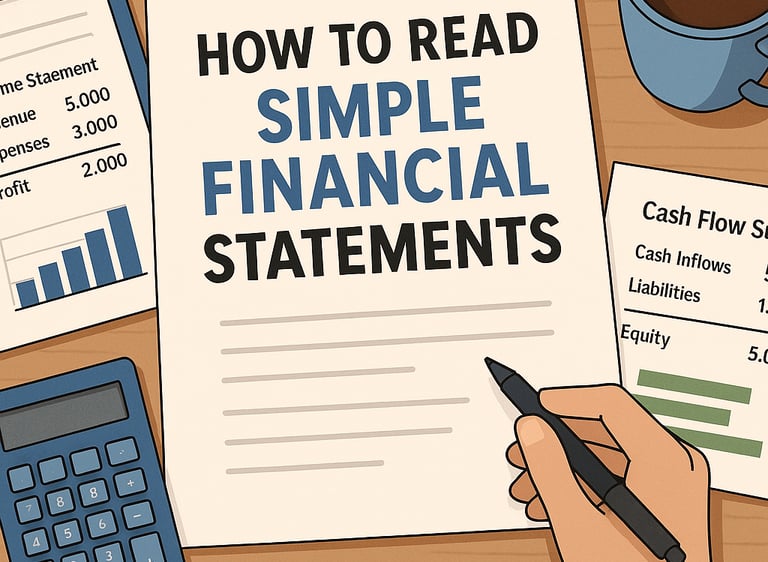How to Read Simple Financial Statements
SMART FINANCIAL STRATEGY


How to Read Simple Financial Statements
(Even If You're Not a Finance Pro)
Whether you're a freelancer, business owner, or content creator, understanding basic financial statements is crucial to making smarter business decisions.
Here’s a quick breakdown of the 3 core financial statements:
1. Profit & Loss Statement (P&L)
Also known as the Income Statement, this shows:
Revenue (money you earned)
Expenses (costs you incurred)
Profit (what’s left over)
Why it matters: It tells you if you're actually making money.
2. Balance Sheet
This gives a snapshot of:
Assets (what you own)
Liabilities (what you owe)
Equity (your net worth)
Why it matters: It shows your financial position at a specific point in time.
3. Cash Flow Statement
This tracks:
Cash Inflows (where your money is coming from)
Cash Outflows (where your money is going)
Why it matters: Profit doesn’t always mean cash. This shows your actual liquidity.
Key Tip:
Look for trends across months or quarters. Numbers alone don’t tell the full story—direction and consistency do.
Scenario: You run an online tutoring business.
1. Income Statement (P&L): Are You Actually Profitable?
🔍 Sample P&L for March:
Item Amount ($)
Revenue 5,000
Tutor Payments 2,000
Software & Tools 300
Marketing Spend 700
Net Profit 2,000
🧠 How to read it:
Your total revenue is $5,000.
After deducting expenses ($3,000), your profit is $2,000.
That’s a 40% profit margin, which is solid.
What to look for:
Is your profit margin consistent month to month?
Are certain costs creeping up over time?
2. Balance Sheet: What’s Your Business Worth Today?
Scenario: You're checking your balance sheet on March 31st.
🔍 Sample Balance Sheet:
Assets Liabilities Equity
Cash: $6,000 Credit Card: $1,000 Retained Profit: $5,000
🧠 How to read it:
You own $6,000 in cash.
You owe $1,000, leaving $5,000 in equity.
This means your business has a positive net worth.
What to look for:
Are your liabilities increasing faster than your assets?
Do you have enough assets to cover short-term obligations?
3. Cash Flow Statement: Where’s the Money Going?
Scenario: In April, you notice good profits—but your bank balance is low.
🔍 Sample Cash Flow:
Activity Cash In Cash Out
Client Payments 5,000
Paid Tutors 2,000
Bought New Laptop 1,500
Marketing Campaign 1,000
Net Cash Flow +500
🧠 How to read it:
You earned well, but your cash outflow (especially the one-time laptop expense) shrank your bank balance.
Even profitable businesses can face cash crunches.
What to look for:
Separate recurring vs. one-time expenses.
Monitor whether your operations are generating cash consistently.
Actionable Insights for Beginners:
✅ Start reviewing your financials monthly—even 30 minutes can highlight risks.
✅ Use simple tools like Google Sheets or software like Wave/Xero to track.
✅ Focus first on cash flow, then on profitability, and lastly on net worth.
You don’t need to be a finance wizard. You just need to read your numbers like a story—they’ll tell you where to go next.
